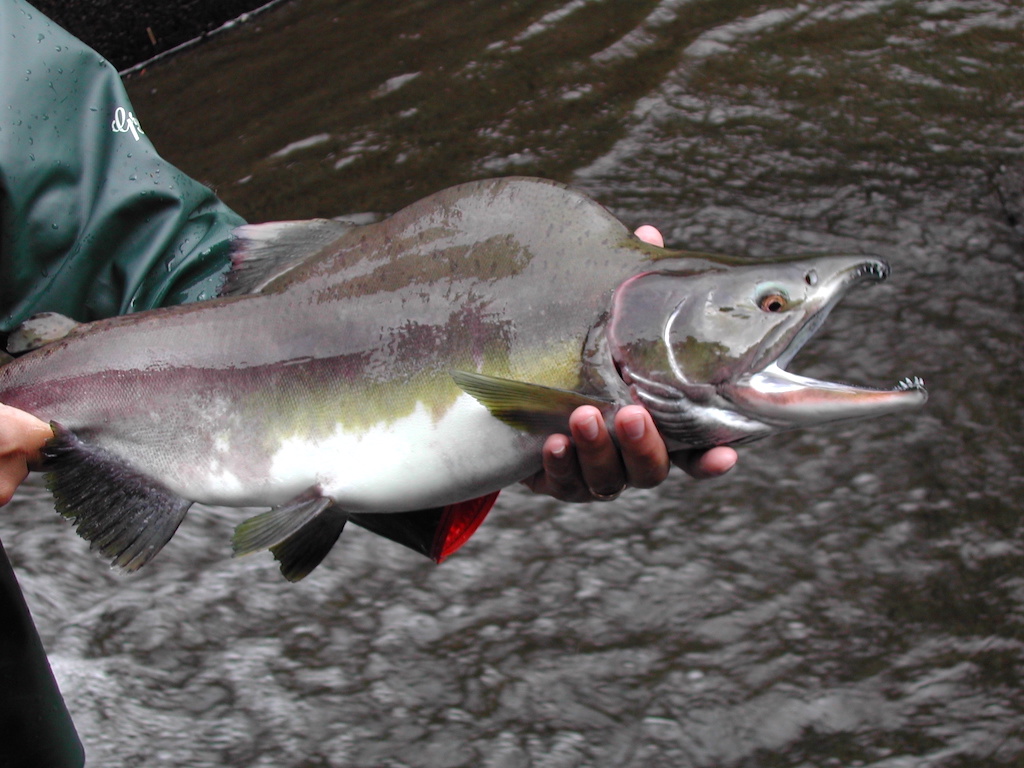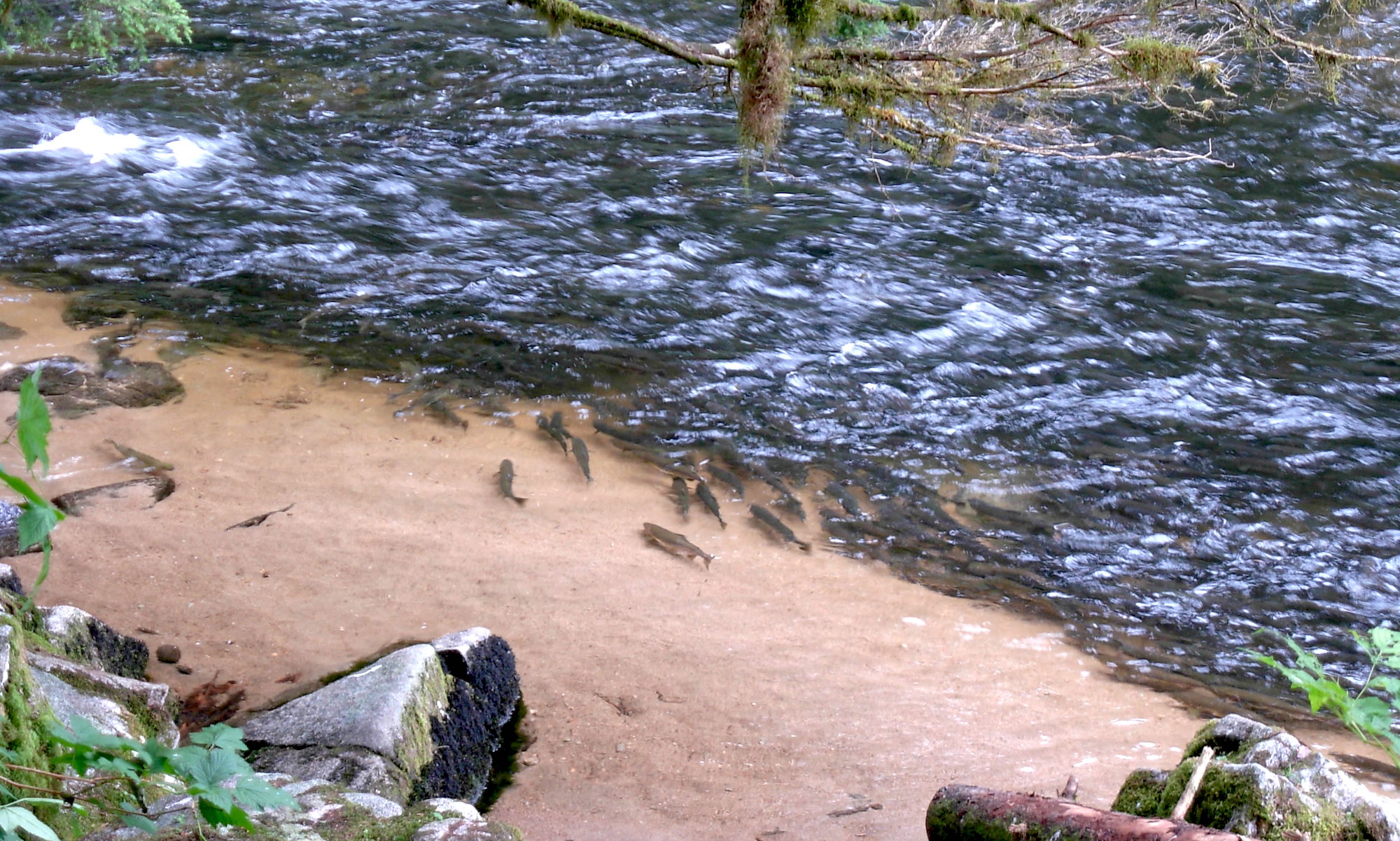One of the most well-worn tropes in Pacific salmon conservation and management circles is that of crossing a river on the backs of the fish. You hear it a lot, in different contexts (historical, ecological), adapted to different geographies: “Ah, in the days of yore,” some old timer will say, “you could walk across the [X] River on the backs of all the salmon, so great were those runs.” The salmon in question are usually Chinook or coho or sockeye, the lament being that their present-day runs are so puny that if one were to try to cross such a river on their backs — to say nothing of propping an entire industry — even the most optimistic yarn spinner would drown within a few feet of shore.
Left out of this lament is that there actually is a species of salmon whose runs these days might qualify for such tale telling. So robust is the species, in fact, that the North Pacific now has more salmon than it did a century ago. It’s just that the salmon are neither Chinook nor coho nor sockeye: they are pink.
Chinook salmon have a harder time finding food when the seas are full of pink salmon. Coho salmon tend to weigh less. Steelhead smolt survival rates drop. Seabirds find less food, they lay eggs later.
The pink salmon (Oncorhynchus gorbuscha) is sort of the also-ran of the Pacific salmon. In size it is the runt. Where the largest of the family, the Chinook or king salmon, might weigh up to fifty pounds when fully mature — and that’s still less than half of what the fabled June Hogs may have weighed — the pink tends to top out at a little over three pounds. Add to this its somewhat comic appearance. When male pink salmon return to spawn, they grow a distinct hump on their backs, giving the species its nickname: Humpy. Finally, for a family of such culinary renown, the pink salmon is generally not considered to be as tasty. “I guess it’s okay if you eat it right away out of the ocean,” says Greg Ruggerone, a fisheries scientist. “But if you store it overnight in the fridge the flesh gets mushy, and it doesn’t have a lot of flavor.”

A male pink salmon (Oncorhynchus gorbuscha) that returned to spawn in Whatcom Creek. The distinct hump that develops during spawning gives pink salmon the nickname “humpy.” Photo: Earle Steele, (CC BY-NC-ND 2.0)
Ruggerone works with Natural Resource Consultants in Seattle. For decades, he has studied the pink salmon. He may not think much of its taste, but he has a healthy appreciation for the species’ ecological heft. For what the pink salmon lacks in flavor, it more than makes up for in number: It is by far the most abundant of all the Pacific salmon. Between 2005 and 2021, seven out of every ten salmon in the North Pacific were pinks. "In some years,” Ruggerone says, “pinks make up about 80% of all salmon and they are about 300 times more abundant than Chinook salmon.”
The other — or one other — remarkable thing about pink salmon is their pronounced biennial cycle. Unique among the salmonids, pink salmon are often twenty-five times more numerous in odd-numbered years than in even-numbered years. No one knows exactly why this is, although there are some informed speculations, but for Ruggerone and some colleagues, the phenomenon had all the makings of a large-scale natural experiment: Does it matter that an upper trophic-level species is predictably, intermittently, ridiculously abundant? Can you detect what you suspect the effects of that abundance might be in other marine species? And can those effects be both far-reaching and profound?
The answers to all of those questions, Ruggerone suspected, was yes. In a recent paper in Marine Ecology Progress Series, he, Alan Springer, and their co-authors argue that the effects of pink salmon abundance are felt far and wide. “In those odd-numbered years of high pink salmon abundance,” Ruggerone says, “they really start a trophic cascade in the North Pacific and the Bering Sea.”
The cascade starts near the bottom, with zooplankton. Large copepods, which are an important prey of pink salmon, become less abundant in the face of hordes of pink salmon, and fewer zooplankton leads to more phytoplankton. The impacts on zooplankton then pass through a host of forage fish: having to compete with pink salmon, Pacific herring of all ages grow more slowly; sand lance recruitment and abundance decline more than 10-fold; Atka mackerel grow more slowly. Chinook salmon have a harder time finding food when the seas are full of pink salmon. Coho salmon weigh less. Steelhead smolt survival rates drop. Seabirds find less food, they lay eggs later. Even their very survival patterns are linked to pink salmon. The birds don’t even have to breed in the North Pacific. Biologists have found that short-tailed shearwaters, which breed in the South Pacific but spend the boreal summers in the North Pacific, were in poorer physiological condition in years of high pink salmon abundance. Then to whales: humpback birth rates drop, as do killer whale birth rates, while their mortality rates increase. All on a two-year cycle.
The list goes on. “The observation that’s fascinating,” Ruggerone says, “is that pink salmon abundance explains these biennial patterns in other species better than oceanographic conditions. Pink salmon abundance has been growing steadily since 1977.” The question is how long these biennial patterns and high abundances might persist. Unlike other salmon species, pink salmon are enjoying a renaissance in warming seas. “They really seem to have benefitted from climate change,” Ruggerone says. Pink salmon are no longer exclusively Pacific salmon, having entered the Arctic Ocean while also colonizing the Barents Sea and the North Atlantic, due in part to deliberate stocking by managers in Russia. But as the ocean continues to warm, Ruggerone suspects that pink salmon will run up against their limit of thermal tolerance. Eventually their numbers will stabilize, and begin to decline.
In the meantime, the findings from Ruggerone’s paper could have significant ramifications for managers. In Alaska, for instance, hatchery systems in Prince William Sound and elsewhere release millions of pink salmon into the North Pacific every year. At present, about 16% of adult pink salmon are hatchery-origin. “People are starting to ask whether it’s a good idea to be releasing so many pinks,” Ruggerone says. “They don’t seem to need much help from us, and you can see the effects they’re already having.”

